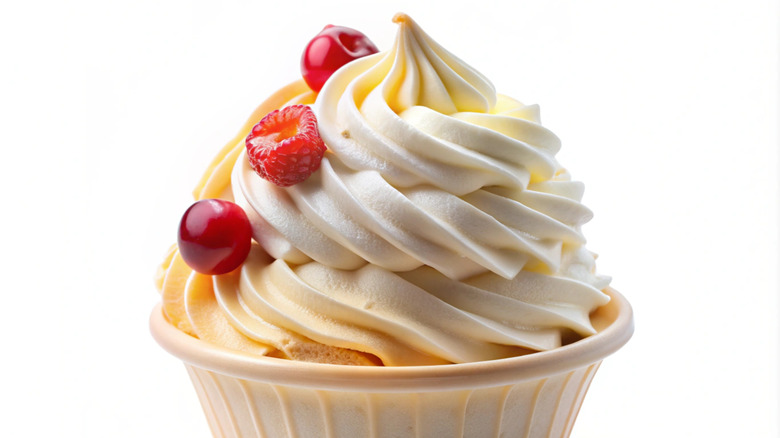The Secret Ingredient For Extra-Rich Frozen Custard And Why It Works
Cool and sweet like ice cream, dense and chewy like gelato, dipped and swirled like soft serve — frozen custard seems to share traits with all of the cold, dairy-rich desserts we know and love. If you're lucky enough to live near a Kopp's or Abbot's franchise or if a fair happens to be passing through town, you can always step out and enjoy a frozen custard, but it's nigh impossible to recreate this summertime sweet treat at home... or is it? As it turns out, if you add a little corn syrup to your ice cream recipe, you can enjoy frozen custard anytime you like!
The reason corn syrup can help you create frozen custard at home has to do with crystallization. Corn syrup behaves a lot like invert sugar, a syrup mixture made from regular sugar that has been broken down through a process called hydrolysis into two components, glucose and fructose. Invert sugar is sweeter and less prone to forming large sugar crystals when frozen, which results in a smoother, creamier consistency. Corn syrup has similar qualities, though it's made from corn starch and can have varying amounts of glucose and maltose. Like invert sugar, corn syrup is often used to prevent crystallization and enhance food textures.
How to make frozen custard at home
If you've ever made a plain vanilla bean ice cream, you'll know that a lot of homemade ice cream recipes have custard bases, which essentially means they're made of an egg, dairy, and sugar mixture. Although there are some no fuss shortcuts, the basic recipe calls for sugar and egg yolks blended together until the mixture reaches a ribbon-like consistency. After heating milk, cream, and vanilla bean, the most important step while making custard ice cream must happen through a process called tempering, when the egg mixture is gradually combined with the hot milk. Done slowly and with constant stirring, tempering allows the egg blend to get warm without curdling the proteins.
What really makes frozen custard different from other custard-based ice cream all boils down to the machine in which it is made. In addition to the added eggs and butterfat, frozen custard is churned in machines which are designed to minimize the amount of air whipped into the custard, as opposed to ice cream, which is manufactured with as much air as possible, a term called "Overrun." These specialized machines also freeze custard at lower temperatures — 16 to 20 degrees Fahrenheit as opposed to 22 to 24 degrees Fahrenheit for ice cream — and stored at 18 degrees Fahrenheit (10 degrees Fahrenheit for ice cream) to maintain its soft texture. Corn syrup helps you achieve that nice creamy texture without any special machinery.
If you attempt to recreate this state fair favorite at home using corn syrup, just remember to make only enough frozen custard as you and your family can consume in one sitting, because any leftovers stored in the freezer will harden to the texture of ice cream.

